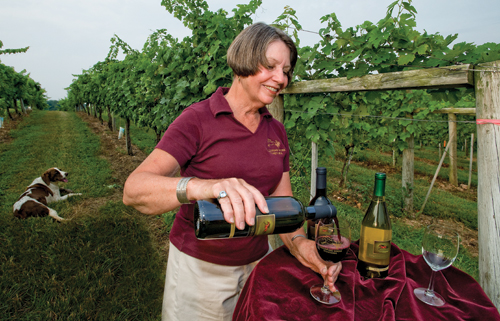
With her grapevines in the background, Diane Hale, of Hampstead’s Galloping Goose Vineyards, pours a glass of the establishment’s product for tasting.
Written By Lisa Breslin, Photos by: Phil Grout
Clarity, color, intensity, “nose,” complexity, balance and finish are common components of wine rating. But when the expected 20,000 people visit the Carroll County Farm Museum for the 28th Annual Maryland Wine Festival on Saturday, September 17, and Sunday, September 18, few will be connoisseurs. Most will be people who just want to be with their friends and perhaps make new ones. They will, however, be better equipped to appreciate the products of the more than 30 wineries represented at the festival if they know a few basic criteria.
“For wine experts, the festival provides the opportunity to focus on tasting a certain style of wine or a certain varietal of wine, the opportunity to meet winery owners and winemakers, and the chance to meet other wine lovers,” said Greg Lambrecht, who, with his wife, Karen, owns Serpent Ridge Vineyard, Westminster.
Proprietors of local wineries and wine experts in the region know that wine selections can be daunting for some.
“A lot people are intimidated by the process, whether they are at a festival or looking at a wine list at a restaurant or picking a wine at a wine shop,” said Meggan Robinson, a Westminster associate with the Miami-based national Southern Wine and Spirits distributor who has been teaching people about wine and selling it for 13 years. “My advice is always not to overcomplicate it. Do you like it? Then that is what you should drink.” Here are a few tips to guide the amateur wine taster through the festival:
Experts’ Criteria
The most important factor is a balance between the elements: Fruit, acid, tannin, sugar and alcohol. If those are in balance, the wine is made well. Wine makers measure all of those elements, but the taste must be harmonious. Whether or not you like it is another decision all together. You might not care for sweet wines but many of them are well made. – Meggan Robinson, Southern Wine and Spirits
Wine experts first know the regional character of each wine. They look at the clarity and color of the wine, evaluate the aroma, then taste it. They take all of this into consideration when determining whether the wine meets their expectations. – Diane Hale, Galloping Goose Vineyards. Hampstead
How to Select and Appreciate Wine
One of the largest hurdles in winemaking in Maryland is the perception that all local wines are sweet or fruity [they are not]. – Karen and Greg Lambrecht, Serpent Ridge Vineyard, Westminster
The Regional character of the wine. Sometimes novices tend to feel all wines should be “Oaked Chardonnays” or High Alcohol Cabernets. – Diane Hale, Galloping Goose Vineyards Hampstead
Novices don’t always understand what a dry wine is. Dry wine is not related to the way that a wine tastes. Dry wine means that all sugar is taken out – but if grapes are sweet, people will still taste sweetness, just not from sugar. A sweet wine can be sweet and also dry – dry relates to the fermentation of the yeast. – Meggan Robinson, Southern Wine and Spirits
Factors to consider Is it:
Fruity, like blackberries, plums, grapefruits, and melons? Floral, with perfumes of violets, lily, rose? Herbal, with hints of mint, hay, tarragon and rosemary? Earthy, reminding you of mushrooms and dry leaves? Spicy: sharp like clove, cinnamon, pepper, spices? Nutty, with of oak, hazelnut, almond, pistachio?
The Nuances of Wine Tasting
Clarity, Color, Intensity, “Nose,” Complexity, Balance and Finish are common components of wine rating, according to bettertastingwine.com
Color
For red, is it cherry-colored, maroon, ruby or brownish? For white, is it light-green, pale yellow, buttercup yellow, golden, or amber? Is the wine clear or cloudy?
Implications: The color of wine indicates its age. Red wines lose color as they age, while white wines gain color as they age. An older red will be clearer and have brownish tints. A very old white wine will have a bronze-gold color or even amber.
Aroma
Bouquet and “nose” are often used to describe a wine’s aromas. Bouquet is used to indicate rich and complex aromas.
Taste
Body: the volume and weight of wine. Descriptions of milk products are generally used to portray a wine’s character. For example, cream is full-bodied; regular milk is medium bodied; and skim milk is light bodied.
Flavor: Is is sweet or acidic? Spicy or tasteless? Is it tannic, dry and bitter?
Finish: does it have a long aftertaste? Take a solid sip of wine, let it flow along your tongue. Note if it is sweet, acidic, or tannic. Take a second solid sip, suck in air to feel how the wine opens up in your mouth. Spitting out the wine is unnecessary; though some people do that to stay sober.
The 28th Anniversary Maryland Wine Festival¨
September 17-18, 2011
Saturday 10-6 p.m., Sun 12-6 p.m.
Carroll County Farm Museum, Westminster, Carroll County

